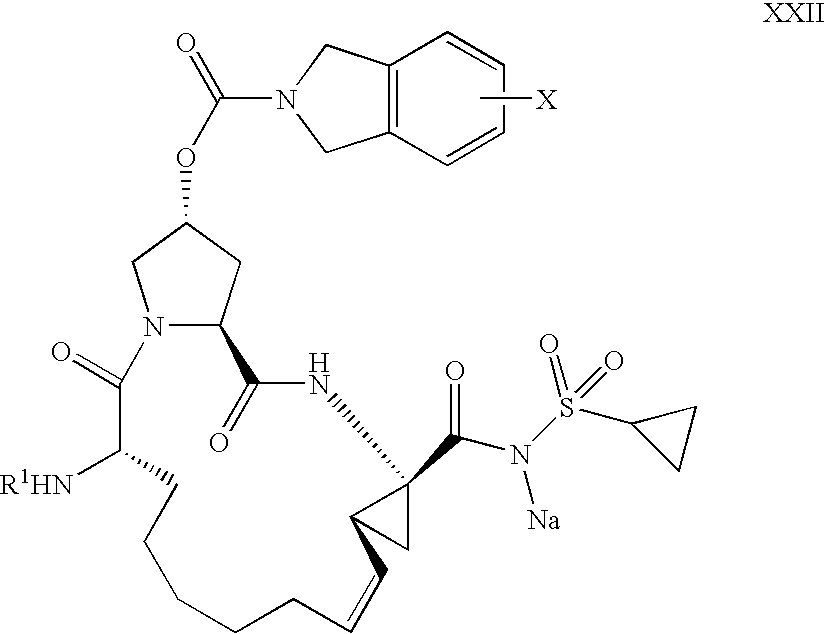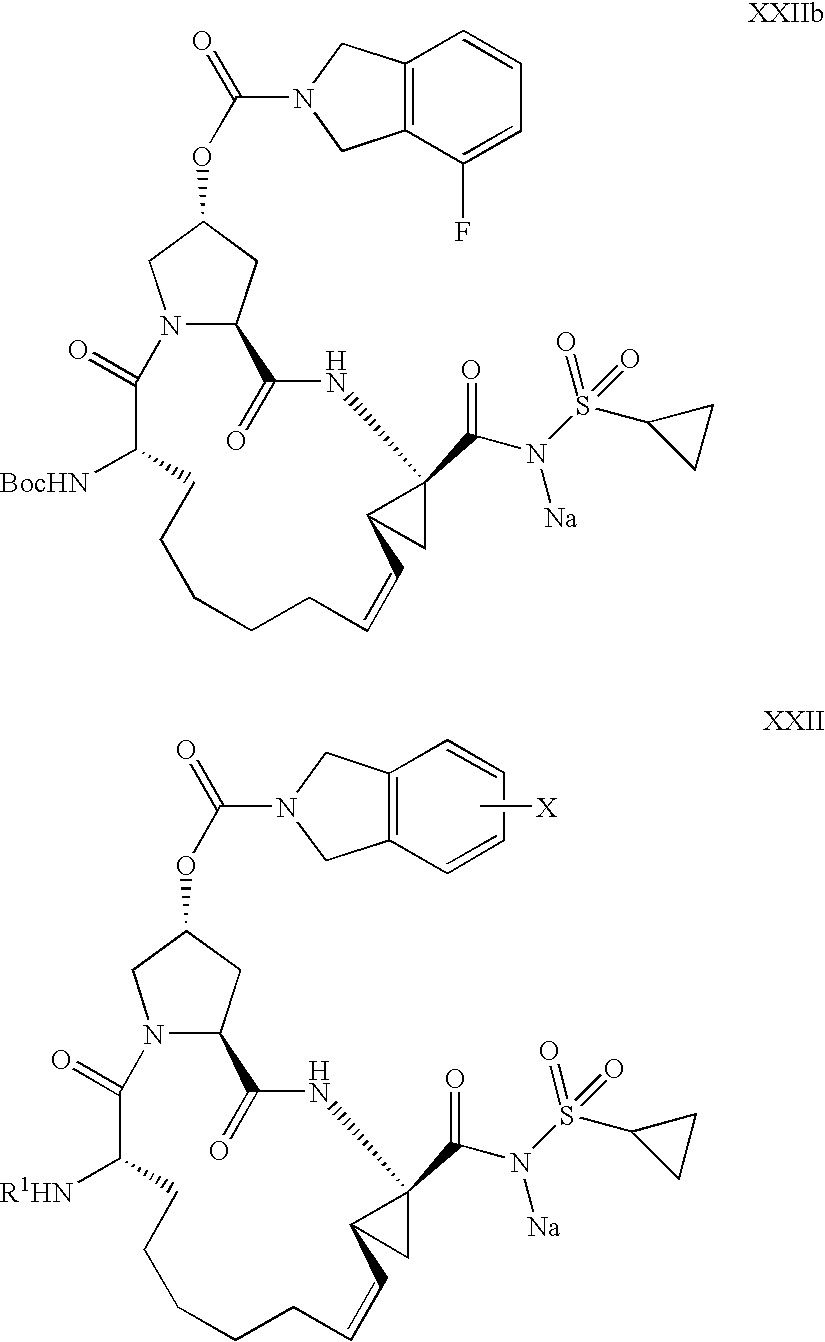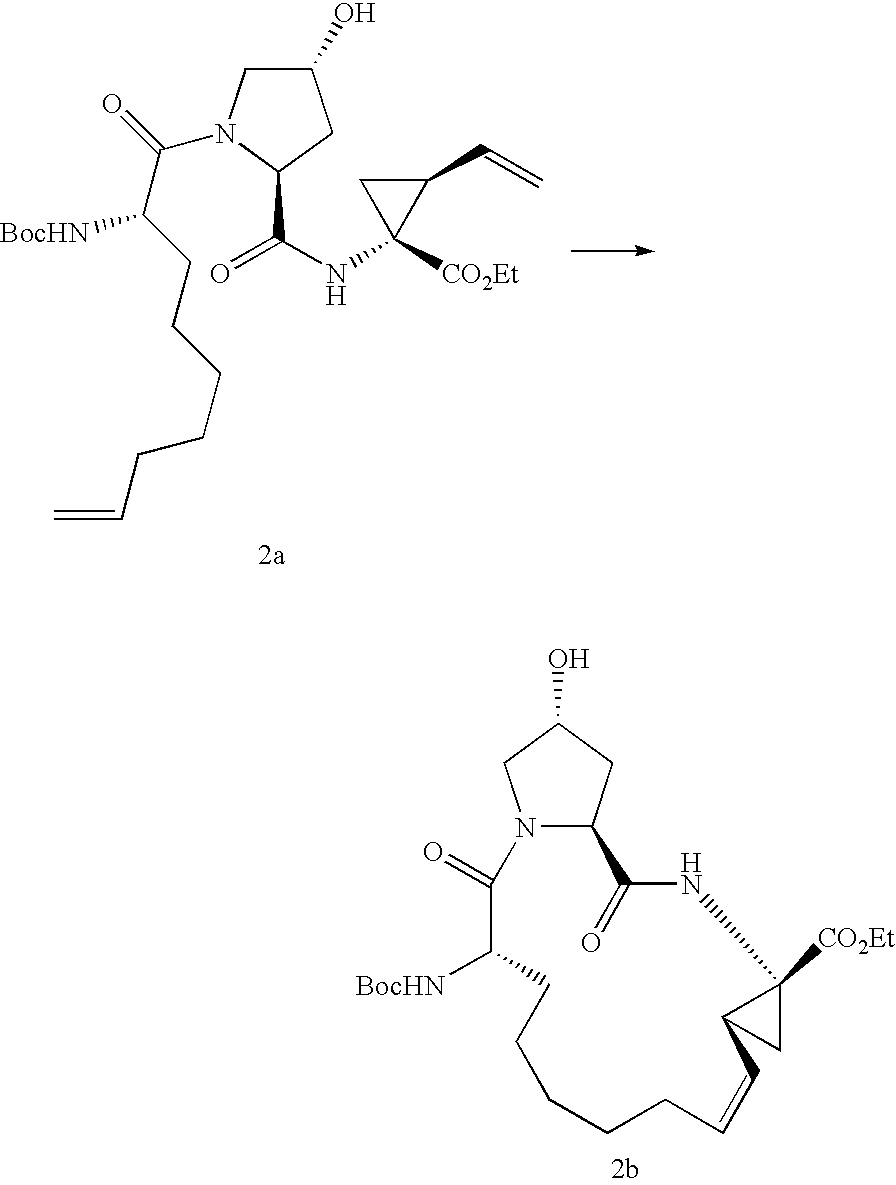Process for the preparation of a macrocycle
a macrocyclic, protease inhibitor technology, applied in the direction of physical/chemical process catalysts, bulk chemical production, organic-compound/hydride/coordination complex catalysts, etc., can solve the problems of low efficiency and high cos
- Summary
- Abstract
- Description
- Claims
- Application Information
AI Technical Summary
Benefits of technology
Problems solved by technology
Method used
Image
Examples
examples
[0116]Abbreviations:
[0117]Boc=tert-butyloxy-carbonyl[0118]r.t.=room temperature[0119]ImH2Mes=1,3-bis-(2,4,6-trimethylphenyl)-2-imidazolidinylidene[0120]ImMes=1,3-bis-(2,4,6-trimethylphenyl)-2-imidazolylidene[0121]ImH2Pr=1,3-bis-(2,6-diisopropylphenyl)-2-imidazolidinylidene[0122]RCM=ring closing metathesis[0123]S / C=molar substrate-to-catalyst ratio[0124]Mes=2,4,6-Trimethylphenyl[0125]a %=HPLC area %
[0126]Diene XV: 4-Fluoro-1,3-dihydro-isoindole-2-carboxylic acid, (3R,5S)-1-[(S)-2-tert-butoxycarbonylamino-non-8-enoyl]-5-[(1R,2S)-1-ethoxycarbonyl-2-vinyl-cyclopropylcarbamoyl]-pyrrolidin-3-yl ester.
[0127]N-acetyl-Diene IIb: 4-Fluoro-1,3-dihydro-isoindole-2-carboxylic acid (3R,5S)-5-[acetyl-((1R,2S)-1-ethoxycarbonyl-2-vinyl-cyclopropyl)-carbamoyl]-1-((S)-2-tert-butoxycarbonylamino-non-8-enoyl)-pyrrolidin-3-yl ester
[0128]N-propionyl-Diene IIc: 4-Fluoro-1,3-dihydro-isoindole-2-carboxylic acid (3R,5S)-1-((S)-2-tert-butoxycarbonylamino-non-8-enoyl)-5-[((1R,2S)-1-ethoxycarbonyl-2-vinyl-cyclop...
example a
[0144]
[0145]To a solution of the diene XV (40.0 g, 53.80 mmol, 92.1% content) in 330 mL of tetrahydrofuran were added under argon 22.70 mL (163.5 mmol) of triethylamine, 6.90 g (161.6 mmol) of lithium chloride and 15.0 mL (159 mmol) of acetic anhydride and the mixture was stirred at 60° C. (internal temperature) during 6 h, after which time only 2 area % of diene XV had remained unreacted. The slightly cloudy reaction mixture was cooled, filtered and the precipitate washed with tetrahydrofuran. The combined filtrates were rotary evaporated to dryness (40° C. / 180 mbar). The oily residue was dissolved in 500 mL of ethyl acetate and extracted with 300 mL of hydrochloric acid 0.5 M. The aqueous phase was back-extracted with a total of 1 L ethyl acetate. The combined organic phases were washed with 300 mL of hydrochloric acid, 300 mL of deionized water, then dried with 70 g of sodium sulfate and filtered. The filtrate was treated with decolorizing charcoal, filtered and rotary evaporated...
example b
[0148]
[0149]To a solution of the diene XV (15.3 g, 22 mmol) in 120 mL of tetrahydrofuran were added under argon 6.8 g (67 mmol) of triethylamine, 2.9 g (67 mmol) lithium chloride and 6.4 g (49 mmol) of propionic acid anhydride. The mixture was heated to 80° C. for 10 h 30 min and then cooled to room temperature at which it was stirred for another 11 h. After this time in-process control showed 99.6% (HPLC) conversion. o the mixture 100 mL water and 3.5 mL aqueous HCl (37%) were added. The biphasic mixture was extracted with ethyl acetate, the aqueous layer was separated off and the organic layer was washed with 100 mL of brine. The aqueous layers were back extracted with 200 mL of ethyl acetate. The combined organic layers were dried over sodium sulfate, filtered and concentrated to dryness. 26.8 g of an oily brown residue was obtained. The oily residue was purified by column chromatography (600 g silica gel 0.040-0.063 mm) and eluted with a mixture of hexane and ethyl acetate using...
PUM
| Property | Measurement | Unit |
|---|---|---|
| concentration | aaaaa | aaaaa |
| concentrations | aaaaa | aaaaa |
| reactivity | aaaaa | aaaaa |
Abstract
Description
Claims
Application Information
 Login to View More
Login to View More - R&D
- Intellectual Property
- Life Sciences
- Materials
- Tech Scout
- Unparalleled Data Quality
- Higher Quality Content
- 60% Fewer Hallucinations
Browse by: Latest US Patents, China's latest patents, Technical Efficacy Thesaurus, Application Domain, Technology Topic, Popular Technical Reports.
© 2025 PatSnap. All rights reserved.Legal|Privacy policy|Modern Slavery Act Transparency Statement|Sitemap|About US| Contact US: help@patsnap.com



